
Eleven years ago this month, both Apple and Google threw a couple of monkey wrenches into the dashboard “drag race” then taking place among all the automakers, foreign and domestic. In their collective efforts to design the very best UX (user experience) in the car, all thirtysomething of them were failing epically. You can look up their pitiful report cards in the annual J.D. Power ratings used to score every aspect of the cars and trucks we drive. When it came to those ever-complex dashboards, most consumers were experiencing frustration and even anger about being able to perform once simple tasks in their vehicles – like tuning in a favorite station, for example.
The problems? Each auto manufacturer or OEM (original equipment manufacturer) was designing their dashboard systems with insufficient audience research. And each was also racing to achieve the best solution, leaving little-to-no uniformity in the way they worked. Back in 2014, you might somehow master the SYNC system in your Ford Focus. But fly to Orlando with the family for your Disney World trip and rent a, say Chevy Malibu or a Toyota Camry and you were back to square one. And there’s nothing more aggravating than pulling out of a rental car lot, managing driving directions in a new city, and you’re struggling with how to listen to the radio or connect your phone.
Enter Apple and Google almost simultaneously with their CarPlay and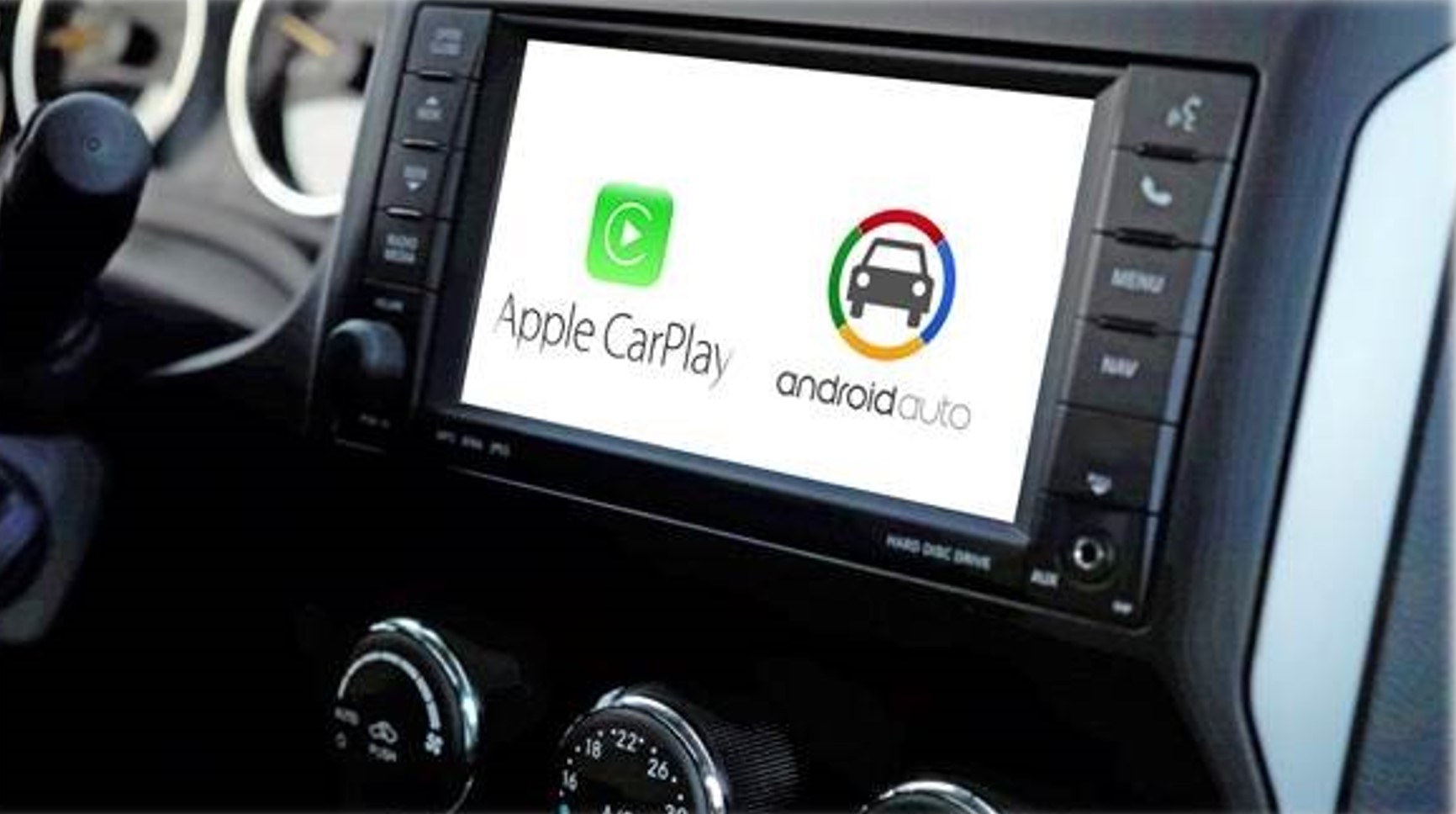 Android Auto solutions that matched up and mirrored the smartphone system of your choice. And all of a sudden, there was a comfortable familiarity when you got behind the wheel – familiar apps packaged similarly to their array on your trusty phone. And even better, if you jumped in your partner’s car or you grabbed a rental on business, you were almost instantly connected to the same old screen you were accustomed to seeing in your own vehicle.
Android Auto solutions that matched up and mirrored the smartphone system of your choice. And all of a sudden, there was a comfortable familiarity when you got behind the wheel – familiar apps packaged similarly to their array on your trusty phone. And even better, if you jumped in your partner’s car or you grabbed a rental on business, you were almost instantly connected to the same old screen you were accustomed to seeing in your own vehicle.
We’ve been tracking the growth curves of both Apple and Android’s efforts in the biggest study of core radio listeners on the planet, Techsurvey. With this year’s study just days away from being presented, I’ve been leaking interesting data points, like the one below;
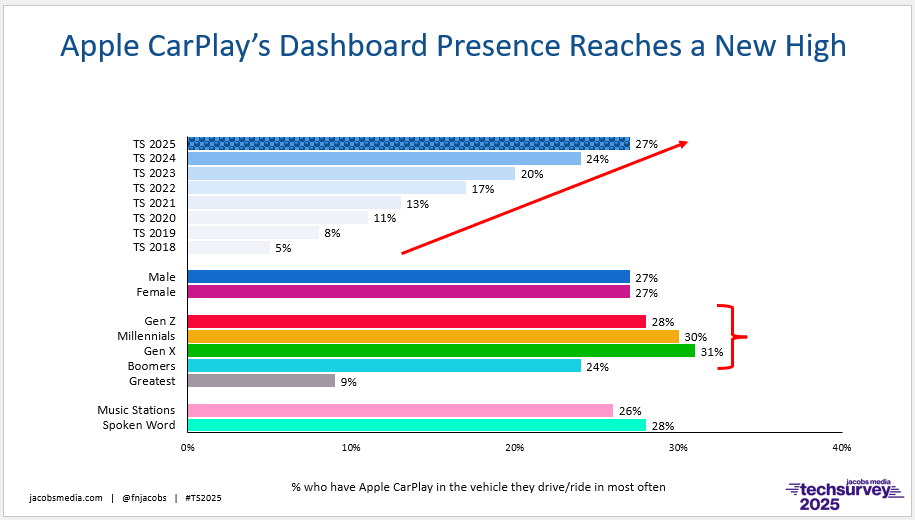
Slow, steady, and impressive growth – especially for CarPlay. And how about those demos?
Over the last decade or more, Apple and Android’s victories over the OEMs’ various infotainment systems hasn’t stopped these intrepid carmakers from continuing to refine and design their proprietary systems. After all, they’ve been ceding a great deal of valuable branding points as well as reams of data to both of these “trillion dollar death star” tech companies, as marketer Evan Shapiro refers to massive companies like Apple and Google. It rankles auto execs to rely on a generic system like CarPlay or Android Auto when they could develop a proprietary solution on their own.
If only it was that easy. But in all this time, few car companies have truly achieved much in the way of individual success with their dashboard design and development efforts. And when you pay tens of thousands of dollars for a new vehicle, you should expect better.
While you can sympathize with the OEMs’ collective frustration, it doesn’t change the reality that many new vehicles are running multiple systems with myriad voices. It’s confusing, to say the least.
How many of us have risked serious collisions while fiddling with a touch screen, trying to get it to perform a task that seems well beyond the car or the driver’s capabilities? Allstate even based an ad in their “Mayhem” series around uncooperative touchscreens:
Many cars have as many as three voices that may – or may not – respond to a command: Siri (or “Hey Google”), Alexa, and the native system in your car, be it Mr. Lexus or Ms. Toyota. It’s like learning to speak a second or a third language – and there’s no Babbel or Rosetta Stone to shepherd you through it.
Perhaps the most stubborn of the OEMs is General Motors. Over the years, they have poured millions into their dashboard software, with user metrics they tried to sell to radio broadcasters, and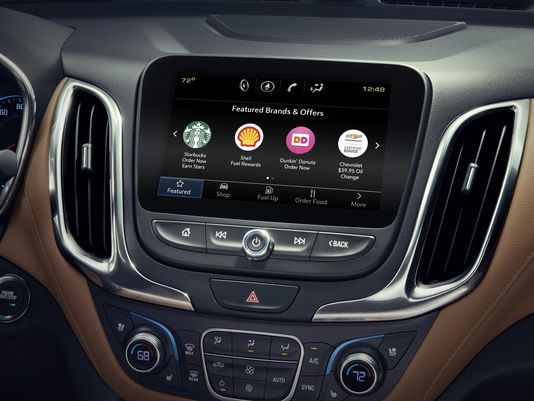 later, with a failed direct purchase system in the car that enabled drivers to buy everything from gas to food to coffee while motoring around town – or the country. The latter “innovation” – an app called “Marketplace” – might have competed head-to-head with local and national radio sales reps. But GM couldn’t get it off the ground. After five frustrating years, GM killed “Marketplace” three years ago.
later, with a failed direct purchase system in the car that enabled drivers to buy everything from gas to food to coffee while motoring around town – or the country. The latter “innovation” – an app called “Marketplace” – might have competed head-to-head with local and national radio sales reps. But GM couldn’t get it off the ground. After five frustrating years, GM killed “Marketplace” three years ago.
None of these failed efforts has stopped the Detroit-based automaker – the biggest of the Big 3 – to stop trying. Also back in 2023, GM introduced its most controversial – and wrong-headed – dashboard debacle to date. As I blogged at the time, despite its popularity, GM opted to not include CarPlay in many of its models, especially EVs.
Even more puzzling is looking at the consumers buying and leasing electric vehicles – skewing younger. That’s right – many of the same drivers who are especially fond of Apple CarPlay.
I very well realize that mega-corporations the size of GM conduct more audience research than the average radio broadcasting company. But they’re either asking the wrong questions or they’re ignoring their findings.
The last two years in Techsurvey we asked how car buyers would react upon learning the vehicle they’re about to take out for a test drive isn’t equipped with CarPlay. While most say they’d be unaffected, one in ten says it’s a “deal-breaker,” while an additional one-fifth are bothered by the omission of CarPlay, indicating they’d think twice before pulling the trigger on a GM car or truck without it. And compared to last year’s survey, a growing number – now more than three in ten – is rankled by this dashboard decision.
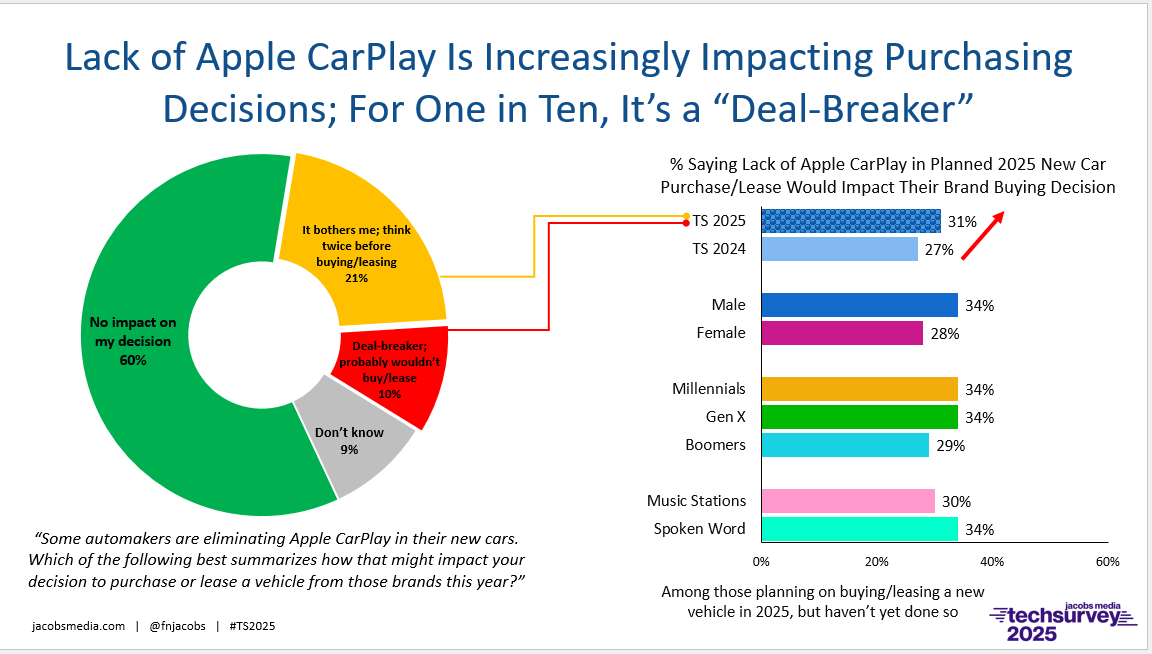
One in ten?
In an increasingly dicey economy, no automaker can afford to have 10% of their potential deals go bad because of what has become a basic convenience feature for many drivers simply is not included.
And in the “Add insult to injury department,” a story broke over the weekend in 9t05Mac written by Chance Miller. According to their reporting, GM has killed the only CarPlay aftermarket kit a consumer could use to add it (and Android Auto) back to the company’s EVs.
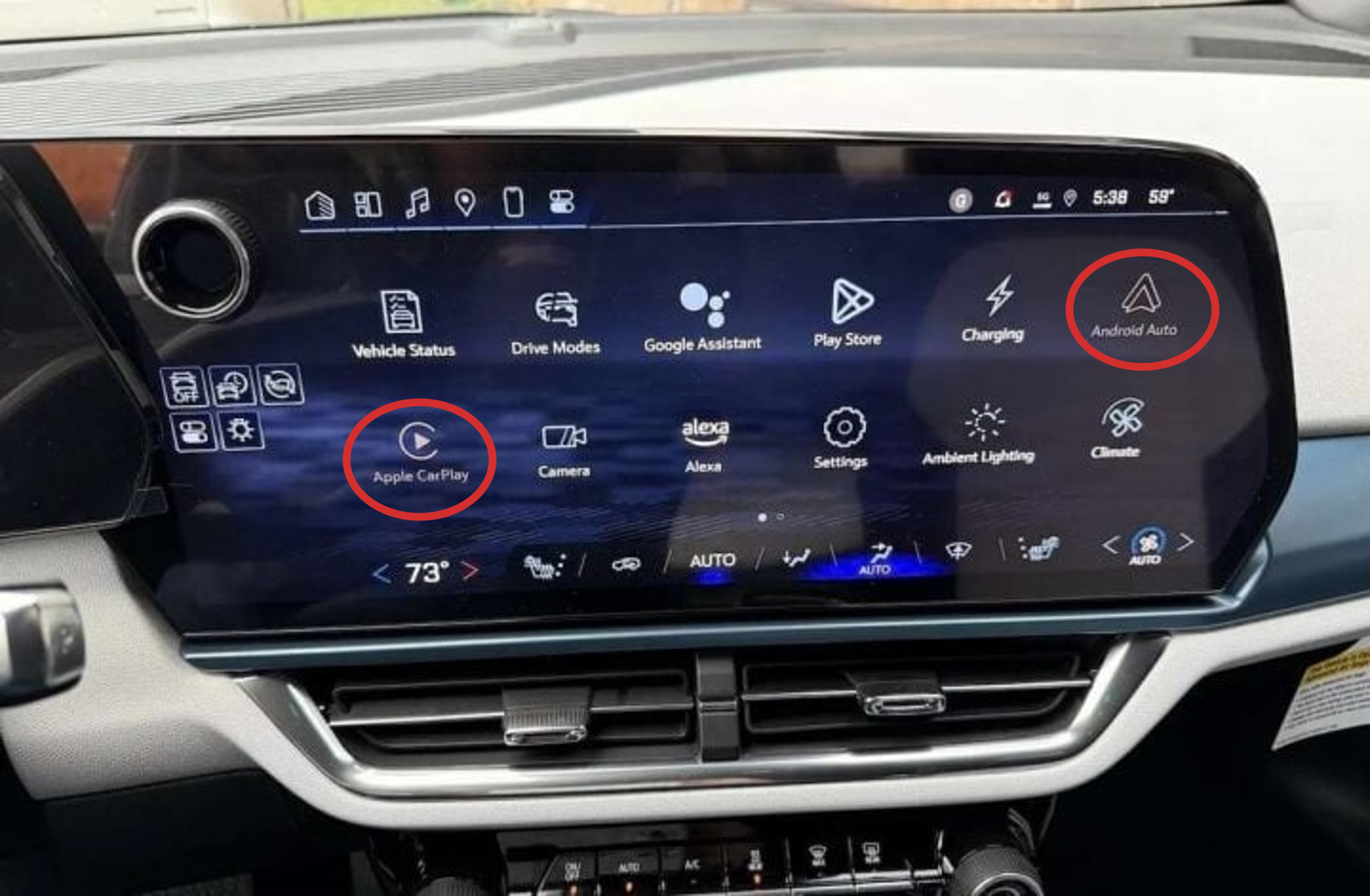
Made by White Automotive, the upgrade was sufficiently complicated so it could only be installed by a GM dealership. And now the company is refusing to even do that. Here’s their statement:
“Aftermarket services that introduce features not originally designed, thoroughly tested, and approved by GM may cause unintended issues for customers. These issues could affect critical safety features and may also void portions of the vehicle’s warranty.”
White Automotive has discontinued the Apple CarPlay/Android Auto retrofit solution. Obviously, GM is adamant about making sure their customers cannot get a feature they love.
A publication called GM Authority polled their readers – obviously P1s of the company. And a whopping 88% of them called the lack of CarPlay a “dealbreaker” in a listener poll.
Piss off the audience at your own peril. In what is already shaping up to be a challenging year, GM is holding fast to making its customers buy their preferred dashboard system.
This is not going to end well.
In tomorrow’s post, more new insights from Techsurvey 2025 – it’s a look at how advanced dashboard systems are eroding radio’s “king of the car” reputation.
- For Radio, The Perils Of Rebranding - May 30, 2025
- There’s No Failure In Radio - May 29, 2025
- It’s Not An Innovation If You Can’t Make It Work – And Last - May 28, 2025




I’ll be in the market for a new car soon….currently in a Ford Escape with the SYNC system and Apple CarPlay. I would never even consider a vehicle that didn’t have AM/FM radio, SiriusXM and Apple CarPlay. I’m a constant consumer of Waze for directions and listen to CNN or MSNBC on Sirius. The music on SiriusXM doesn’t sound good…too many channels squeezed into a too small tube, but the radio station’s app on the phone through Apple CarPlay has great sound quality. Heading for San Diego in the fall and already made sure to rent a car with Apple CarPlay installed.
Jimmy, I totally get it. Over time, we figure out what we’re comfortable with and what we need to adequately entertain ourselves. You are a very likely a much more discerning in car listener today than you were just a few years ago. Thanks for the comment.
I have found that the audio quality from the XM satellites is better than that from the Sirius satellites. Check which of the two systems your car has installed. The company’s promotion of the combined “SiriusXM” brand doesn’t negate the facts in the sky: They’re separate technologies.
Seriously, if I an unable to use Car Play (I’m on iPhone) or Android Auto its a deal-breaker.
Who needs another subscription in my budget?
GM is also one of the leaders in the push to eliminate AM Radio from their cars. My view is that, it being free media, AM is doomed in the GM dashboard. And so is FM. Why would they include those when they can make you subscribe to something that generates revenue for GM.
Thom, you’ve hit on a consistent problem vis a vis GM customer experience. I would never expect them to support radio for the sake of…well, tradition. But if large percentages of ther base is indredulous about the absence of AM and/or FM radio, that makes a statement about customer expectations. Appreciate the comment.
I recently went to lease another Hyundai Kona…
The device for shifting gears is now:
A lever where the windshield wipers usually are.
The salesperson admitted there was a learning curve.
Going from park, to reverse, to drive should not be complicated.
In the space where the shifter used to be is…well…space.
The salesperson said that women wanted somewhere to put a big purse.
Huh?
So I went next door and leased a KIA.
While the gear shift is where it’s supposed to be…
I now have interior lights that flash to the beat of the music.
I’m going to have to figure out how to turn off that needless feature.
Sounds about right, Marty. The OEMs typically don’t do a great job putting themselves in the shoes of their listeenrs. And yes, unpopular features that make you wonder if anyone on the management team has actually sat behind the wheel of one of their vehicles. Otherwise, we’d be seeing more features simply go unused because they’re totally meaningless to most drivers.
Do I need to replace my FM converter now?
Not having Carplay or Android Auto would be deal breaker for me. Its important for me that the software “mirrors” my phone and could care less what the automaker thinks. If nothing else, its a safety issue. Weird to say this as I’m new to all of the car technology but am glad things like Carplay or the blind spot monitor is there.
Now don’t get me started on some recent Carplay software update and that Siri doesn’t play nice anymore.
You make a great point, they are just letting customers walk away.
CarPlay (I cannot speak for Android Auto) can be sketchy and even a bit frustrating for many drivers. I recently reented a Hyundai SUV and I liked the interface better than my Lexus. But all in all – little annoyances aside – the CarPlay experiencce is pretty solid from vehicle to vehicle, OEM to OEM.
When we look at the “infotainment systems” that companies install in their cars’ dashboards, it’s usually a much different story. The quality varies greatly from one vehicle to the next, and there are very few “standard” features you’d expect to see across a wide spectrum of cars. Thus, it’s not uncommon when you get behind the wheel of a vehicle you’ve never driven to be met with confusiosn and angst.
Bottom line: GM is clearly losing sight of what’s important to their customers,
Heapslapper. Fortunately, my 2019 GMC Canyon has Apple Carplay. Without it, the frustrating entertainment system would be pointless. I tend to use Carplay to find and listen to the radio.
So, since GMCs do not have Carplay now, I guess I will take Marty’s cue and buy a Kia next time.
Well, the good news, Wade, is you actually have a lot of cars to choose from. By their own choice, GM is the outlier here. Thanks for the comment.
The two cars I routinely drive happen both to be 2010 models, neither “connected.” Their dashboard infotainment systems are straightforward, both including Sirius and with Aux inputs. A few days ago, while traveling, my rental car was a 2025 Chevy Equinox and it made me feel like Rip van Winkle. The infotainment system was alien and almost indecipherable. Trying to figure it out, my negotiation of the Boston freeways was definitely impaired, I’m embarrassed to admit. Regardless of whether it has Carplay or Android Auto, no way would I consider buying such a user-surly vehicle.
Forward to the past, please.
I am afraid all this confusion on the present dashboard units is going to fade into the ashcan of history with the introduction of the DTS AutoStage dashboard unit.
Its technology has been developed by Xperi-Tivo and was developed in conjunction with HD Radio.
Its in 11 million cars allready in the US including Toyota RAV4’s and BMW’s and may account for the increasing sales of those cars to the detriment of GM and Ford; and is in something like 140 million cars in Europe..
It has many great and needed tech features also including AM radio. It has been accepted by the NAB as what the standard equipment should be in any car sold in the US, It was developed with the help of broadcasters at home and abroad.
If GM and Ford don’t put it in their cars, I am afraid for there car sales appeal.
My next new car purchase is about to be ordered and it will be one with DTS Autostage in it so that puts me to buyiun a ToyataRav4 or a BMW. Goodbye to controversy and confusion and bad decisions on what the dashboard informaiton and entertainment unit should be.
Please write about it’s features and what it can do. . , .
:
Hi Tony, we’re on the same page about Xperi’s platform. I have blogged about it many times here, and we take a tour of radio execs to Xperi’s booth at CES every year so they can experieince AutoStage firsthand. Hopefully, Xperi will be successful in getting it adopted in more car models over the next few years. Thanks for your comment.